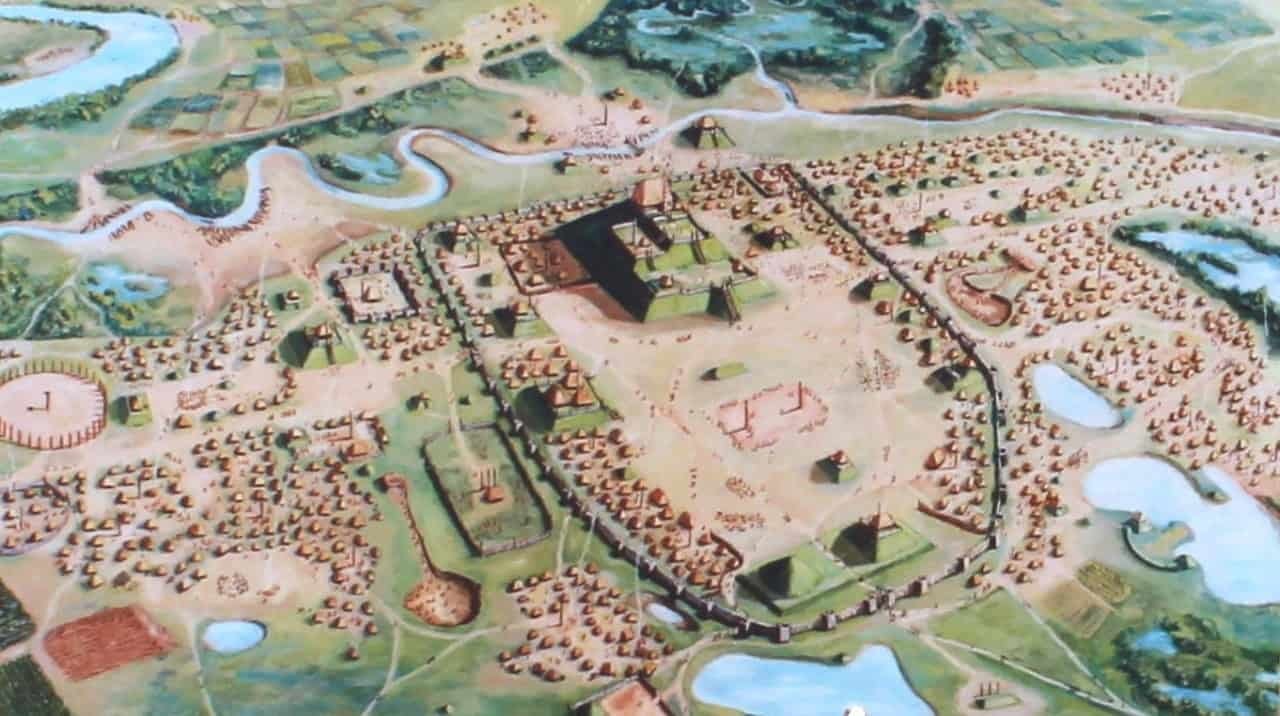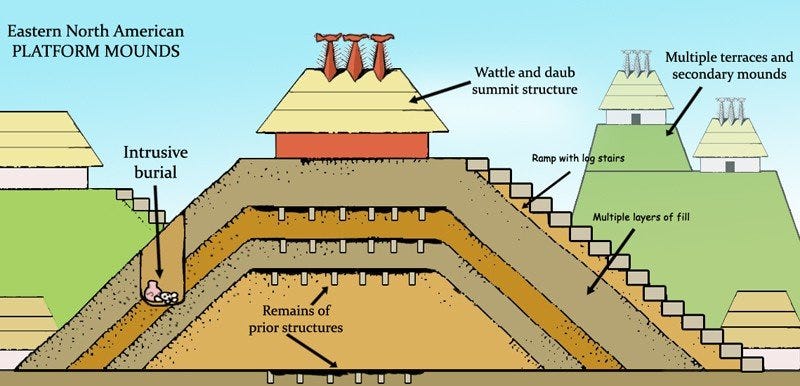Cahokia Mounds: The Largest Ancient City in North America
America's forgotten city was the home of 40,000 people more than 1,000 years ago
In Southern Illinois, situated along the Mississippi River in Collinsville, an ancient settlement that we call Cahokia rose to great power between 800-1200 CE. Nicknamed America’s Forgotten City or The City of the Sun, the massive complex once contained as many as 40,000 people and spread across nearly 4,000 acres. The most notable features of the site are hand-made earthen mounds which held temples, political buildings, and burial pits. Cahokia Mounds are a testament to the highly organized culture of the early Mississippian people who built the largest city in pre-Columbian North America.
Small villages first emerged along Cahokia Creek beginning around 600 CE. Subsequently, the climate warmed and more rain found its way to Southern Illinois. Thus, villagers could easily grow an abundance of food. As a result, thousands of people migrated to the area around the Mississippi River. Then as time went on, the Mississippians created a unified culture all their own and began building mounds across their land in the ninth century.
By about 1000 CE, the Mississippians had built the largest civilization in North America. In fact, some people have referred to it as a kingdom, because the Mississippian culture reached up to the Great Lakes and down to the entire southeastern region of North America. The city became the pre-eminent center of religious and political power and may have even controlled a vast trade network from the Rocky Mountains to the Gulf of Mexico.

Although today we call the site Cahokia Mounds, no one knows the original name of the city. French explorers in the 1600s named Cahokia after the Cahokia tribe, which lived in the area around that time. However, they may not have had any relation to the original mound builders.
Culture of the Mound Builders
The Mississippian culture may have originated and, indeed, reached its apex at Cahokia Mounds. The mound builders lived in the Mississippi Valley, Ohio, Oklahoma, and into the midwest and southeast. They worshipped the Sun and other celestial beings within a well-developed religion. Additionally, their lives revolved around warfare, and sacrifices were common. In many ways, however, it was the impressive Cahokia mounds that defined the culture of the Mississippians.
Contrary to early beliefs, the Mississippian mound-builders had sophisticated farming tools, pottery, astronomy, and copper-work. Religion, cosmology, and an organized pantheon of gods were central in the Mississippian life and led to the development of temples within the Cahokia mound complex.

The game of chunkey emerged during the region’s early occupation. This was an important sport in which a player rolled a stone disc and had to throw a spear as close to the stopped stone as possible. The Mississippians played this game in the grand plaza surrounded by the largest mounds in the capital. However, this was not all for fun. The losers and their family members paid with their lives in ritual sacrifice.
Building the Cahokia Mounds
There were three types of mounds: flat-top platform, conical, and ridge-top. The most common was the platform mound.
Most of the mounds were built between the ninth and 13th centuries.
The purposes of the mounds varied. Platform mounds with flat tops supported dwellings, temples, and stages for festivals and religious/political ceremonies. Conical and ridgetop mounds appear to have served as burial sites and landmarks.
Clay, topsoil, shells, or stones served as the materials in Cahokia mound construction. The largest mounds contained a high percentage of clay to hinder water seepage and erosion.
All the mounds were hand-made. Workers dug or gathered building material from one area and carried it in baskets on their backs to the construction site. They tamped soil and clay one layer at a time to create the earthen mounds.
Cahokia’s Important Features

Monks Mound
Of the many structures within Cahokia Mounds, the most impressive is Monks Mound pyramid. Archaeologists believe that fourteen successive stages of construction took place between the years 900 and 1100 (Unesco). Containing over 25 million cubic feet of soil, the mound rises 100 feet into the air and covers 14 acres. These staggering figures make the Monks Mound pyramid the largest prehistoric earthen structure north of Mexico.
Monks Mound is a towering central structure amidst four large plazas in the city. It overlooked the Grand Plaza surrounded by the stockade. On the top of the mound, a large wooden building sat surrounded by a protective palisade wall. The purpose of the building is uncertain. However, because few artifacts related to dwellings existed during excavations, experts believe it may have been a place for the dead or a site of political and religious council. Additionally, religious ceremonies may have taken place there as well. In fact, Monks Mound may have held a central place in the cosmos of Mississippian religion that symbolically connected the “Sky Realm” with the “Earth Realm.” Thus, Mississippians would have regarded the site as a highly potent religious and political symbol. (Romain).
Woodhenge
It was important for the Mississippians to know when to plant, harvest, and celebrate the solstices and equinoxes. Therefore, they had at least five wood henges strewn around the city that served as calendars at various times. This allowed them to track the sun and seasons with a high degree of accuracy. Circular configurations of wooden posts served as the markers. Four equidistant posts marked the solstices and equinoxes, while posts in between tracked the mid-seasons.

In 1961, Dr. Warren Wittry first discovered a set of 28 poles that stretched 410 feet in diameter. Four additional circles surfaced later. Of these five circular patterns built out of the red cedar (sacred to Native Americans), one set contains 24 posts, one has 36, one has 48, one has 60. The last circle, which has yet to be fully excavated, is made of 72 posts.
Keep reading with a 7-day free trial
Subscribe to Historic Mysteries to keep reading this post and get 7 days of free access to the full post archives.



